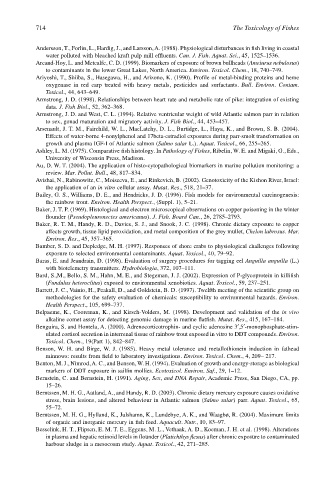Page 734 - The Toxicology of Fishes
P. 734
714 The Toxicology of Fishes
Andersson, T., Forlin, L., Hardig, J., and Larsson, A. (1988). Physiological disturbances in fish living in coastal
water polluted with bleached kraft pulp mill effluents. Can. J. Fish. Aquat. Sci., 45, 1525–1536.
Arcand-Hoy, L. and Metcalfe, C. D. (1999). Biomarkers of exposure of brown bullheads (Ameiurus nebulosus)
to contaminants in the lower Great Lakes, North America. Environ. Toxicol. Chem., 18, 740–749.
Ariyoshi, T., Shiiba, S., Hasegawa, H., and Arizono, K. (1990). Profile of metal-binding proteins and heme
oxygenase in red carp treated with heavy metals, pesticides and surfactants. Bull. Environ. Contam.
Toxicol., 44, 643–649.
Armstrong, J. D. (1998). Relationships between heart rate and metabolic rate of pike: integration of existing
data. J. Fish Biol., 52, 362–368.
Armstrong, J. D. and West, C. L. (1994). Relative ventricular weight of wild Atlantic salmon parr in relation
to sex, gonad maturation and migratory activity. J. Fish Biol., 44, 453–457.
Arsenault, J. T. M., Fairchild, W. L., MacLatchy, D. L., Burtidge, L., Haya, K., and Brown, S. B. (2004).
Effects of water-borne 4-nonylphenol and 17beta-estradiol exposures during parr-smolt transformation on
growth and plasma IGF-I of Atlantic salmon (Salmo salar L.). Aquat. Toxicol., 66, 255–265.
Ashley, L. M. (1975). Comparative fish histology. In Pathology of Fishes, Ribelin, W. E. and Migaki, G., Eds.,
University of Wisconsin Press, Madison.
Au, D. W. T. (2004). The application of histo-cytopathological biomarkers in marine pollution monitoring: a
review. Mar. Pollut. Bull., 48, 817–834.
Avishai, N., Rabinowitz, C., Moiseeva, E., and Rinkevich, B. (2002). Genotoxicity of the Kishon River, Israel:
the application of an in vitro cellular assay. Mutat. Res., 518, 21–37.
Bailey, G. S., Williams, D. E., and Hendricks, J. D. (1996). Fish models for environmental carcinogenesis:
the rainbow trout. Environ. Health Perspect., (Suppl. 1), 5–21.
Baker, J. T. P. (1969). Histological and electron microscopical observations on copper poisoning in the winter
flounder (Pseudopleuronectes americanus). J. Fish. Board Can., 26, 2785–2793.
Baker, R. T. M., Handy, R. D., Davies, S. J., and Snook, J. C. (1998). Chronic dietary exposure to copper
affects growth, tissue lipid peroxidation, and metal composition of the grey mullet, Chelon labrosus. Mar.
Environ. Res., 45, 357–365.
Bamber, S. D. and Depledge, M. H. (1997). Responses of shore crabs to physiological challenges following
exposure to selected environmental contaminants. Aquat. Toxicol., 40, 79–92.
Baras, E. and Jeandrain, D. (1998). Evaluation of surgery procedures for tagging eel Anguilla anguilla (L.)
with biotelemetry transmitters. Hydrobiologia, 372, 107–111.
Bard, S.,M., Bello, S. M., Hahn, M. E., and Stegeman, J. J. (2002). Expression of P-glycoprotein in killifish
(Fundulus heteroclitus) exposed to environmental xenobiotics. Aquat. Toxicol., 59, 237–251.
Barrett, J. C., Vainio, H., Peakall, D., and Goldstein, B. D. (1997). Twelfth meeting of the scientific group on
methodologies for the safety evaluation of chemicals: susceptibility to environmental hazards. Environ.
Health Perspect., 105, 699–737.
Belpaeme, K., Cooreman, K., and Kirsch-Volders, M. (1998). Development and validation of the in vivo
alkaline comet assay for detecting genomic damage in marine flatfish. Mutat. Res., 415, 167–184.
Benguira, S. and Hontela, A. (2000). Adrenocorticotrophin- and cyclic adenosine 3′,5′-monophosphate-stim-
ulated cortisol secretion in interrenal tissue of rainbow trout exposed in vitro to DDT compounds. Environ.
Toxicol. Chem., 19(Part 1), 842–847.
Benson, W. H. and Birge, W. J. (1985). Heavy metal tolerance and metallothionein induction in fathead
minnows: results from field to laboratory investigations. Environ. Toxicol. Chem., 4, 209– 217.
Benton, M. J., Nimrod, A. C., and Benson, W. H. (1994). Evaluation of growth and energy-storage as biological
markers of DDT exposure in sailfin mollies. Ecotoxicol. Environ. Saf., 29, 1–12.
Bernstein, C. and Bernstein, H. (1991). Aging, Sex, and DNA Repair, Academic Press, San Diego, CA, pp.
15–26.
Berntssen, M. H. G., Aatland, A., and Handy, R. D. (2003). Chronic dietary mercury exposure causes oxidative
stress, brain lesions, and altered behaviour in Atlantic salmon (Salmo salar) parr. Aquat. Toxicol., 65,
55–72.
Berntssen, M. H. G., Hylland, K., Julshamn, K., Lundebye, A. K., and Waagbø, R. (2004). Maximum limits
of organic and inorganic mercury in fish feed. Aquacult. Nutr., 10, 83–97.
Besselink, H. T., Flipsen, E. M. T. E., Eggens, M. L., Vethaak, A. D., Koeman, J. H. et al. (1998). Alterations
in plasma and hepatic retinoid levels in flounder (Platichthys flesus) after chronic exposure to contaminated
harbour sludge in a mesocosm study. Aquat. Toxicol., 42, 271–285.

